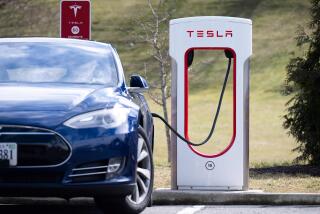Reasons Why Your Engine Might Blow Its Cool
- Share via
Along with lazy days at the beach and smoky ribs on the grill, summer means overheated cars. If your car has a problem with its cooling system, chances are you are going to discover it as temperatures rise into the high 90s and while you are idling in traffic.
It doesn’t seem fair that a car should overheat in the most uncomfortable situations, but that is the typical scenario.
When temperatures recently soared to 112 in Los Angeles, emergency road calls logged by the Auto Club jumped 25% over normal.
Cars are designed to operate in temperatures as high as 120, but such high heat stretches a car’s cooling system to the limit, especially in stop-and-go traffic.
General Motors, for example, tests its cars in Death Valley, subjecting them to long hill climbs at temperatures well above 100 degrees, one of the most severe tests of a cooling system.
While new cars may pass with ease, it is not unusual for things to go wrong with older cars under much less trying conditions.
All cars are equipped with a temperature gauge or a temperature light. When the light comes on, or when the gauge needle enters a red warning zone, it means the engine is close to overheating and reaching the boiling point of the engine coolant.
Most owners’ manuals are not very clear on this point, but in hot weather the engine normally runs somewhat hotter than in cooler weather. Thus, if the temperature goes over 100, the temperature gauge is likely to move past its normal position. As long as the gauge does not pass the red line, the engine will not be damaged.
This means that you have some time to react while the car overheats but before it boils over. If the gauge reaches the red line or the warning light comes on, turn off the air conditioning. If necessary, turn on the heater full blast to help cool the engine. You might melt, but that’s better than being stranded roadside on a hot day.
Most cars are water cooled, but they depend on a steady flow of air to cool the water in the radiator. As the outside temperature rises, it becomes more difficult for the radiator to shed heat. Idling in traffic makes things worse, because there is less air passing through the radiator.
Typically, coolant runs at 220 to 240 degrees, well above the boiling point of water. Most cooling systems will not boil over until the coolant passes 260 degrees, thanks to the antifreeze and the 15 pounds of pressure at which the systems normally operate. So you have a substantial margin before you encounter problems.
Why do cars overheat? If your car overheats, it is either low on coolant, the radiator is plugged with dirt, the engine fan is not operating properly, the thermostat is stuck, the radiator cap is not holding the correct pressure or the water pump is broken.
If the problem crops up only on very hot days or while driving at freeway speeds, chances are the radiator is unable to handle the heat. It could be plugged.
You can purchase a chemical radiator flush at most auto parts stores, but they seldom solve the problem. A radiator shop can disassemble the radiator and mechanically clean it for about half the replacement cost.
A low coolant level means you have a leak that must be located and fixed. Water pumps usually operate properly or fail totally, so there is little question of whether they are at fault in overheating.
If the car overheats only while idling in city traffic, the electric fan is probably not operating correctly, either because the motor is shot or the thermostatic switch is broken.
By changing the antifreeze in your cooling system every year, you can help keep the system clean and avoid many of these problems.







